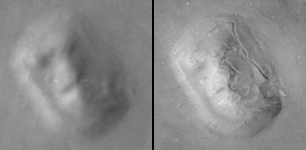Astronomy and the Human World
The College of Science’s February Public Science Lecture was titled “Astronomy and the Human World” and featured a conversation with Michael Schermer. Schermer is the founding publisher of Skeptic magazine and Skeptic.com and the author of books that include “The Moral Arc,” “Skeptic” and “The Believing Brain.” The conversation covered a broad range of subjects from pattern recognition abilities of the human brain to Martian settlements and the social, economic, political, moral and religious systems that could evolve there.
To begin, the word “scientist” was not invented until the 19th century. Contemporaries referred to early scientists as philosophers or natural philosophers. What did the advent of scientific inquiry mean for human civilization? We realized that the world is knowable. That with precise measurements, multiple observations logical reasoning, we can make sense of the world around us.
Pattern Recognition

The human brain can perceive patterns in both meaningful and meaningless data, like the “face” on Mars. When the Viking mission photographed that area in a better resolution, it was found that the “face” was nothing more than a rock formation.
Why do we see these patterns and why are we so often wrong? Schermer explained why. Consider this example: An animal is grazing and hears some rustling noise. It thinks it is due to a predator and becomes more alert. Turns out, this was just the wind. This is a Type I response. The Type II response would have been to dismiss the noise as wind, when it was actually due to a predator. This does not end well for the animal. The Type I response keeps the animal alive, even though it means getting a lot of false positives.
However, we cannot see things that we do not know about – like Galileo and the rings of Saturn. The world had not known about rings around planets before Galileo discovered them. He did not know that they were rings and called them “ears” or probably “three bodies”. Before knowing the truth, we come up with these varied explanations to explain data since we are interpreting our observations. To analyze this further, it is difficult to make sense of observations that precede theory. When we know about something, we set out to find it with a fairly clear idea of what we are looking for; it’s not as easy to devise a new theory that can explain what we saw, especially because we are seeing it for the first time.
Martian Settlements
On the topic of settlement on Mars, Schermer pointed out that selecting people for this expedition would be very difficult as, given the time needed to travel between the two planets, we would need more than just a bunch of highly skilled individuals. We would need a sustainable colony. We would need multiple people with similar and overlapping skill sets. We would need people who would be able to get along with each other when they are all alone, isolated and cut off from terrestrial civilization. It is very obvious that conflicts will arise among a group of people when they have been together for a long enough period of time. How do we solve that problem? What about the laws and rules? Schermer brought up an interesting point: rules change with the number of people. For example, Greek city-states had a population count that was in the thousands. The city-states had public assemblies and were able to make decisions in the presence of all citizens. This just cannot be replicated on a scale of millions of citizens, so we need new rules. The situation on Mars would be similar. In the beginning, there would be a few people, then, as more people come, their rules and regulations would have to evolve. It is intriguing to think about the culture and civilization that would evolve there, away from Earth.

The Ability to Say “I don’t know”
One of the really quintessential facets of a scientist is the ability to admit that they do not know the answer. More often than not, people tend to hide our ignorance by offering a half-true or unverified explanation. Then, we keep defending it, even in the face of overwhelming contradictory evidence.
Schermer quoted Planck when he said,”Science advances one funeral at a time.” A new generation that grows up hearing and reading about a concept do not regard it with as much skepticism or resistance as the generations before them do. For the older generations, it is difficult to accept something that implies a drastic paradigm shift, but the newer generations accept it with ease, thus carrying the torch of discovery and scientific progress further.
In fact, as Batcheldor rightly pointed out, “an unanswered question usually means a Ph.D. for someone.”
One interesting point came up at the end of the conversation: we have made phenomenal progress in science and technology in the last century. Does that mean this is the most glorious age for science? Well, no, as every generation thinks so. It’s not entirely wrong either. We have been doing better than those before us. By that same logic, it’s very likely that those after us would build upon and advance our work further.





